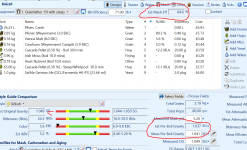Can anyone explain why the Estimated Mash Efficiency in my recipes is way above the max yield for my grains, max yield for the pale malt 80%, est mash efficiency 85%?
Then, when my Actual Mash Efficiency is about 10% lower (75%, which seems about right), I am above the Estimated Mash Gravity?? 1.037 est, 1.041 actual. My est Mach Efficiency is 85% giving an Estimated Mash Gravity of 1.037, I am 10% lower in Mash Efficiency, but 4 points higher in gravity!!
This does not seem logical to me...which means I probably have something set up incorrectly, or just not understanding!
Then, when my Actual Mash Efficiency is about 10% lower (75%, which seems about right), I am above the Estimated Mash Gravity?? 1.037 est, 1.041 actual. My est Mach Efficiency is 85% giving an Estimated Mash Gravity of 1.037, I am 10% lower in Mash Efficiency, but 4 points higher in gravity!!
This does not seem logical to me...which means I probably have something set up incorrectly, or just not understanding!


